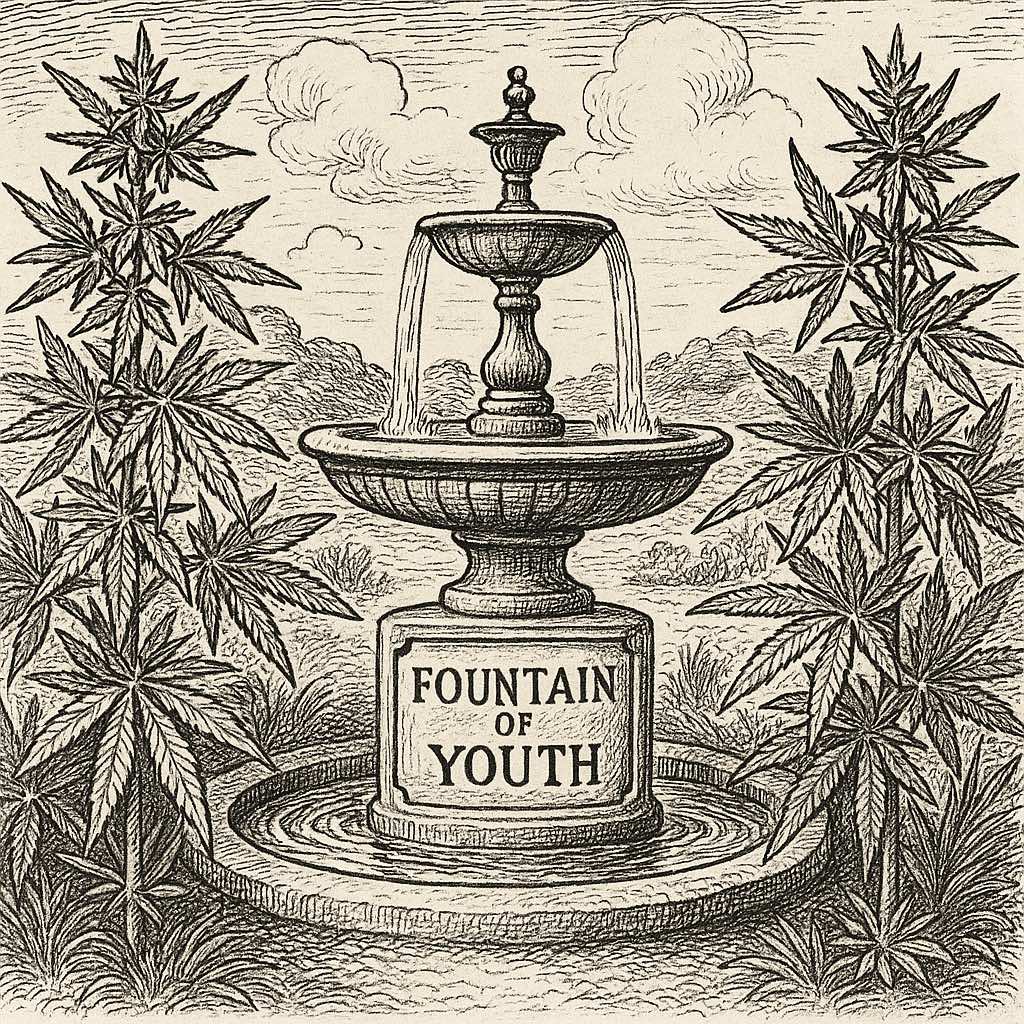
Reflections on The impact of cannabis use on ageing and longevity: a systematic review of research insights by Nain et al. (2025) published in the Journal of Cannabis Research. (Open Access)
Aging is one of biology’s longest-running paradoxes. It brings wisdom but also decline; it slows the body yet can sharpen perspective. Into this riddle steps cannabis, long associated with youth and rebellion, but increasingly used by older adults seeking relief from pain, anxiety, and sleepless nights. Advocacy for elderly cannabis use has even reached the president’s social media feed, signaling how mainstream the discussion has become. The real question is no longer whether seniors use cannabis, but how cannabinoids might contribute to healthy aging, particularly through their potential anti-inflammatory and neuroprotective effects.
A 2025 systematic review by Nain and colleagues in the Journal of Cannabis Research attempted to pull together findings from worms, flies, fish, mice, and human studies. The review emphasized the anti-inflammatory properties of cannabinoids, while also acknowledging a larger truth: the science is fragmented, often contradictory, but undeniably suggestive of real potential.
Science has a habit of starting small. If you want to test the effects of cannabinoids on aging, you don’t begin with retirees in Florida; you begin with worms in a dish:
- Worms (C. elegans): CBD extended lifespan by nearly 18% and improved mobility in later life.
- Fruit flies: Low doses of CBD and THC improved survival after brain trauma, suggesting neuroprotection.
- Zebrafish: Tiny THC doses prolonged survival and reduced inflammatory markers, though higher doses harmed offspring survival.
- Mice: Low-dose THC in aged animals increased hippocampal synapses and reversed memory decline; the same dose impaired memory in young mice.
Across species, the lesson is consistent: cannabinoids can support longevity and brain health, but age, dose, and context are decisive.
The human data are far messier. Several studies in the review linked lifetime heavy cannabis use — especially when begun in adolescence — to poorer cognition, accelerated markers of biological aging, and hippocampal thinning later in life. In contrast, other work suggested that older adults who initiated use later sometimes displayed increased brain connectivity, potentially buffering against age-related decline.
Real-world evidence leans toward cautious optimism. In Canada, more than 15% of adults over 65 report cannabis use. In the United States, senior use nearly doubled between 2015 and 2018. Most older adults are not seeking intoxication but relief: they experiment with tinctures, oils, and low-dose edibles, reporting improvements in sleep, pain, and mood. Some even cut back on opioid prescriptions. Still, without rigorous longitudinal trials, these remain compelling anecdotes rather than conclusive proof.
The data do not suggest that using cannabis as early and as heavily as possible, will bring you healthy immortality. Quite the opposite: the longer one waits to use cannabis regularly, the fewer risks there appear to be. In fact, much of the benefit in later life may not come from cannabis itself, but from what it reminds older adults to do: relax, de-stress, exercise, eat well, and sleep. By the time hair turns grey and white, lifestyle factors such as diet, exercise, and social engagement likely outweigh the influence of casual cannabis use.
Still, the review makes clear that timing matters. Several human studies found that lifetime heavy use, especially beginning in adolescence, was associated with an increased chance of negative outcomes. These findings complicate the rosy picture painted by preclinical models. Yet other research showed that older adults who began using cannabis later in life sometimes displayed increased brain connectivity, potentially offsetting age-related cognitive decline. Survey data add to this nuance: many seniors in Canada and the United States use cannabis primarily for chronic pain, arthritis, anxiety, and insomnia, with some reporting reduced reliance on opioids.
What stands out in the review is a stark contradiction:
- Early and heavy use appears linked to long-term risks: poorer cognition, accelerated aging, structural brain changes.
- Later-life, measured use shows potential benefits: improved brain connectivity, better quality of life, reduced pain, and sometimes less opioid use.
Taken together, these results highlight a central contradiction in cannabis and aging research. Heavy, early use may tax the developing brain, reducing the likelihood of later-life benefits. In contrast, carefully measured use in older age may preserve memory, improve quality of life, and offer modest relief from chronic ailments. Both outcomes are possible, and both are supported by the existing evidence. Timing, dose, and individual context ultimately determine whether cannabis functions as medicine or liability.
The most plausible bridge between these findings lies in inflammation. As the review highlights, cannabinoids like THC and CBD interact with the endocannabinoid system, a regulator of immune function, stress response, and homeostasis. With age, the immune system often turns destructive, fueling chronic inflammation and tissue damage. Cannabinoids’ ability to modulate immune activity may explain their potential to improve healthspan (flexibility for geriatric worms, maze solving for elderly mice, aged flies that can recover from head trauma). So not necessarily just adding years to life but adding life to years.
The 2025 review by Nain and colleagues reminds us that cannabis and aging resist simple verdicts. Cannabinoids are neither miracle cure nor universal hazard; they are context-dependent tools. Heavy, early use may accelerate decline, while careful use later in life may ease it. What emerges is a story of paradox; cannabis can hasten decline if embraced too early, but may soften it if introduced later. The next step is clear: rigorous, long-term studies are needed to separate myth from measurable effect and to answer the most practical question of all: when, for whom, and at what dose can cannabis truly support healthy aging?

